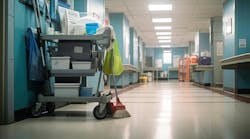School sports are always in season. Whether cleaning during and after a football game, wrestling match, gymnastics meet or other event, the cleaning of sports facilities presents unique challenges. Moreover, the importance extends beyond protecting the health of athletes and fans, as sports facilities often represent a school or university’s public face to the community and alumni.
The following tips are based on the Playbook on Green Cleaning in Sports Facilities that is being developed by the Green Sports Alliance. The Alliance is working with professional leagues including Major League Baseball, the National Football League, the National Basketball Association and the National Hockey League; along with a number of collegiate conferences and teams to help green their sports facilities.
• Green Chemicals For General Cleaning: Use products that were tested for health, environmental impacts and performance by independent organizations such as Green Seal, EcoLogo/UL or EPA’s Design for the Environment Program. Highly concentrated chemicals that are accurately diluted reduce consumption, environmental impacts and cost. Consider new devices, such as those that turn ordinary tap water into an effective cleaning solution.
• Disinfectants: Pay close attention to surfaces such as wrestling mats, gymnastic equipment, weight and other training equipment. Make sure the product is registered with the U.S. Environmental Protection Agency and labeled for the pathogens including strains of staph, HIV and others. Follow the manufacturer’s directions for dilution, application and dwell time. Greener disinfectants are highly concentrated, neutral in pH and low in volatile organic compounds (VOCs).
• Microfiber Mops: Use microfiber flat mops to mop seating areas, stairs and floors as opposed to traditional cotton string mops. Microfiber products clean better and reduce the amount of water used. Microfiber mops are lighter in weight, reducing the potential for back injuries. Floors also dry faster reducing slips and falls. Microfiber mops also help limit water damage to wood surfaces, especially over the long term.
• Waste, Recycling and Composting: Sports events produce a lot of waste, including a higher concentration of food waste and drink containers as compared to the rest of the campus. Make sure that receptacles are widely available and clearly labeled. For large events consider working with a student group to encourage proper disposal during the game and afterwards to help cleanup, especially in the seating area. Recyclables can be retuned for money, while composting should be considered for food waste. And to keep areas clean and odor free, use products made from nonpathogenic bacteria and enzymes.
• Paper and Plastic Liners: Reduce consumption and use recycled materials. Use quality paper, as low quality paper requires more sheets to dry hands. Additionally, using larger rolls can reduce consumption by 30 percent compared to multifold dispensers. Other options such as FSC, Green Seal and EcoLogo/UL certification; or products made with agricultural waste or from rapidly renewable trees (trees that mature in less than 10 years) are also considerations under the USGBC’s LEED Rating System. Use plastic liners that are the right size for the receptacle and the thickness is appropriate to conserve materials (and save money); plus prefer a high amount of post-consumer recycled content.
• Training and Safety: Ensure that workers, especially student volunteers, are properly trained and are using appropriate personal protective equipment such as gloves, goggles, non-slip shoes if working in wet or hazardous conditions.
For more information on the Green Sports Alliance go to www.greensportsalliance.org.
Ashkin is executive director of the Green Cleaning Network, a 501(c)3 not-for-profit educational organization.

